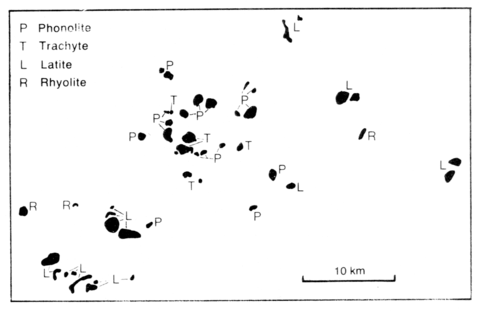stripes
Igneous rocks in the Rattlesnake Hills comprise 42 volcanic vents and intrusions, the latter being principally laccoliths and domes. The main rock types are rhyolite, trachyte, latite and quartz latite, which occasionally contain a little aegirine-augite, and phonolite. Nineteen intrusions are formed of phonolite, as are several small dykes, which contains phenocrysts of sanidine, aegirine or aegirine-augite, hauyne, nosean, occasional amphibole and rare biotite; the trachytic matrix consists predominantly of alkali feldspar, sodic pyroxene, hauyne, nosean, secondary analcime and zeolite, and accessories. A list of all the intrusions with their geographical names and principal rock types is given by Pekarek (1977, Table 2). Collated rock analyses will be found in Pekarek (1977, Table 3) and geological maps in Love (1970, Plate 1) and Pekarek (1977, Fig. 2).
LOVE, J.D. 1970. Cenozoic geology of the Granite Mountains area, central Wyoming. Professional Paper, United States Geological Survey, 495-C: 1-154.
PEKAREK, A.H. 1977. The structural geology and volcanic petrology of the Rattlesnake Hills, Wyoming. Earth Science Bulletin, Wyoming Geological Association, 10(4): 3-20

